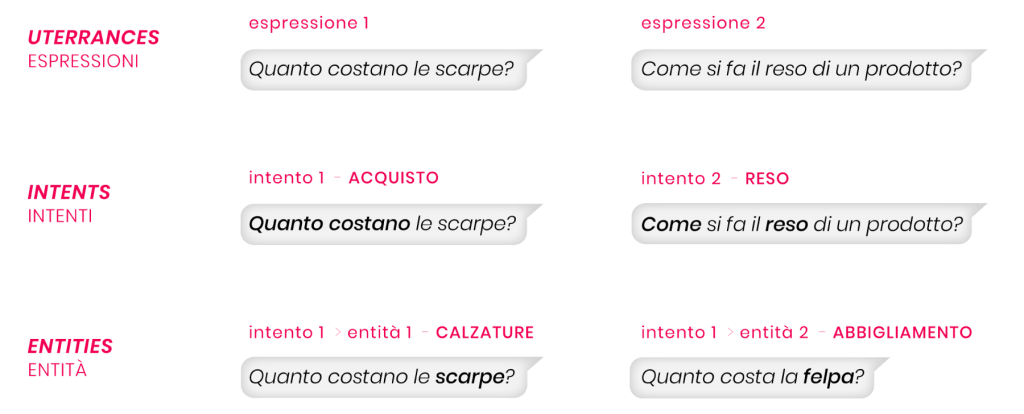What is an AI chatbot?

Glossary
What is an AI chatbot?
A chatbot is a software that can carry on a conversation via chat, interpreting the interactions, questions and answers of the user.
You can usually find them within websites, to offer assistance, allow the user to have information on products or services… But not only that: a well-designed chatbot also makes it possible to perform specific actions automatically, for example it can allow the customer to schedule an appointment directly on your company agenda, upload assistance tickets that will arrive in your email and much more.
Chatbot Terminologies
In order to talk about Chatbots and conversational AI, it is necessary to first do a (very brief) overview of the technical terms and acronyms related to the topic, which, in case you are a layman in the field, will be useful to better understand the next paragraph.
it is a technology that involves Artificial Intelligence, voice recognition and messaging applications in order to interact with the user by simulating conversations very similar to human ones. If the interaction occurs via text, we can talk about Chatbot, if instead a spoken dialogue between man and machine occurs, we will talk about Voicebot.
Natural Language Processing; as the name suggests, it is a set of artificial intelligence algorithms capable of analyzing and understanding human language, mainly in the form of text.
Utterances, are the requests or phrases expressed by the user towards the bot. They trigger the start of the interaction between human and machine.
An utterance could be for example the phrase “is the new model of Teebok in white available?”
Intents are groups of concepts that indicate tasks and actions that the user wants to perform; they are necessary for the bot to interpret the utterances expressed by the human and therefore define the generic intention.
To define the intents, during the bot configuration phase, it is necessary to identify the main concepts that the machine will have to interpret, based on the application scope of the case.
If we wanted to structure the virtual assistant of an E-commerce for example, we should first establish the various areas of intentions within which the utterances expressed by E-commerce users can be divided. The expressions “I want to know how much the shoes cost” or “what is the price of the t-shirt?” will be traced back to the same intent that we could call “prices”; “how can I make a return?” “I would like to exchange a product” could instead fall within the intent “returns”.
Within a user-expressed utterance, entities are the words that define and specify intents, expressing a value or a variant connected to them and therefore defining them in more detail. Entities allow you to contextualize the user’s intentions.
Let’s take the example of our virtual assistant for E-commerce once again, within the same intent “purchases” we could find the sentences (utterances) “I want to buy shoes” and “I want to buy trousers”, where the first indicates the entity “footwear” and the second the entity “clothing”
Also known in Italian as Machine Learning, giving an exhaustive definition is not at all simple, its fields of application are vast and differentiated. We could however say that machine learning includes a series of different mechanisms that allow intelligent machines to increase their knowledge and performance, based on data acquired over time.
Thanks to feedback and corrections (carried out by a human operator in the case of supervised machine learning, or directly by the machine if we are talking about unsupervised ML) the system is able to learn how to perform functions and elaborate increasingly relevant responses.

What types of Chatbots are there?
There are various types of Chatbots, which we could define within three different categories:
- Transactional or declarative chatbots (based on structured interactions)
These bots allow the user to interact based on fixed patterns; being based on pre-established rules, they are solidly structured and not flexible: their ability to respond is in fact based on the recognition via NLP of keywords within the questions asked by the user, which correspond to pre-established response scripts.
These types of chatbots, also called transactional or declarative, are mainly used to automatically perform a single action or function that, generally, does not involve many variables (for example, guiding the user through the appointment-making process through pre-established steps).
- Chatbots based on Conversational Artificial Intelligence
these virtual assistants are more sophisticated than the previous ones and allow fluid and personalized interactions thanks to the use of conversational AI.
Bots based on Conversational Artificial Intelligence require an initial configuration, necessary to “educate” the intelligence through the Machine Learning process. To do this, it is first necessary to establish the intents and create the first emblematic utterances that identify them. The various entities that contextualize the utterances are then defined and, finally, the flow of the interaction is defined(on Dillo the creation of the flow is done through a Chatbot Editor with a No-code logic)
- Hybrid Chatbots with Live Agent
no matter how intelligent and thoroughly trained an assistant may be, the intervention of a human operator within a conversation may sometimes be necessary to satisfy the customer’s needs. In this case, we rely on a hybrid chatbot that, like the previous ones, is able to respond to the end user’s needs, but at the same time allows operators to take control of the chat.
Dillo Chatbot falls into this category of virtual assistants: not only does it allow human agents to intervene during the conversation via a dedicated interface, but it also allows them to transfer the communication to other operators if necessary.
Are you looking for a virtual assistant to improve communication with your customers or automate Customer Care?
Check out Dillo Chatbot or contact our experts and tell us about your project, we will be happy to help you.
See you next time!
Channel
Topics
- What’s a Chatbot?
- Chatbot terminologies
- Chatbot typologies
Tags
- AI, Artificial Intelligence, chatbot, Virtual Assistant
Subscribe to the Newsletter
Stay up to date on Dillo services and advice from our experts!


